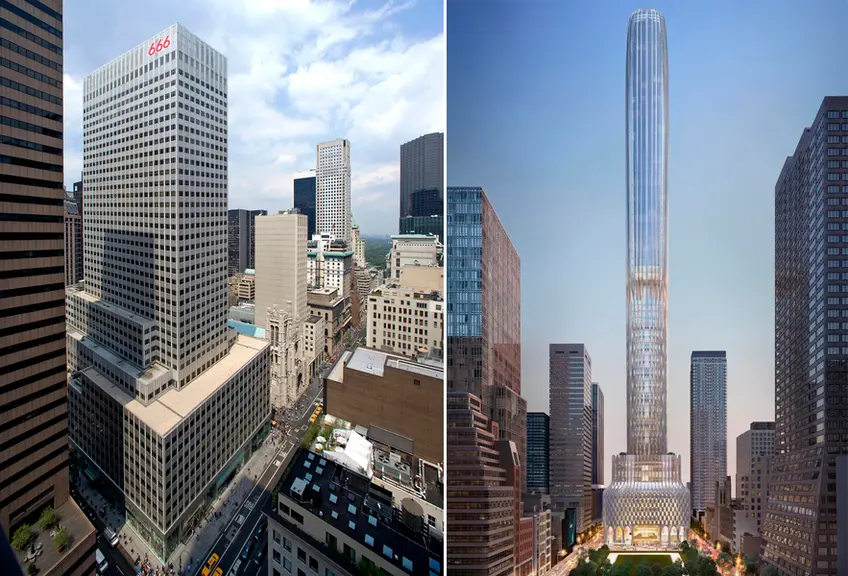 666 Fifth Avenue: Present and Future(?)
666 Fifth Avenue: Present and Future(?)
Earlier this week, The Wall Street Journal printed a rendering of a scheme by the office of the late Zaha Hadid to create a 1,400-foot-high, mixed-use tower on the site of the former Tishman Building at 666 Fifth Avenue between 52nd and 53rd streets.
The article by Peter Grant said the $7.5-billion project would involve stripping the existing 39-story tower of its attractive, embossed aluminum cladding and adding about 40 floors. The existing building was erected in 1957 and designed by Carson Lundin Shaw and is one of only two prominent metal-clad skyscrapers in the city.
The article by Peter Grant said the $7.5-billion project would involve stripping the existing 39-story tower of its attractive, embossed aluminum cladding and adding about 40 floors. The existing building was erected in 1957 and designed by Carson Lundin Shaw and is one of only two prominent metal-clad skyscrapers in the city.
Although the existing building is boxy and bulky, it had a wonderful ground floor with a rounded glass-enclosed center retail space, originally occupied by Olivetti and then Alitalia, flanked by two wide and deep arcades that lead back to a through-block arcade with a stainless-steel waterfall wall in front of the elevator banks that had an undulating stainless-steel ribbed ceiling and a white and dark red marble floor, all designed by Isamu Noguchi, the country’s foremost sculptor.
The tower was erected before the city adopted new zoning to encourage enclosed public spaces such as gallerias and atria and this building innovatively opened up its ground floor significantly.
Sadly, the building has changed hands several times and the original retail spaces have changed dramatically, and for the worse. The partial good news is that Noguchi’s waterfall, and elevator bank ceiling and floors have survived.
The original architecture scheme had an unrelated, one-story retail base beneath its 8-story base supporting its setback, rectangular, slab tower of 31 stories culminating in a broad band at the top with 666 in bright red lights at the avenue end.
The tower was erected before the city adopted new zoning to encourage enclosed public spaces such as gallerias and atria and this building innovatively opened up its ground floor significantly.
Sadly, the building has changed hands several times and the original retail spaces have changed dramatically, and for the worse. The partial good news is that Noguchi’s waterfall, and elevator bank ceiling and floors have survived.
The original architecture scheme had an unrelated, one-story retail base beneath its 8-story base supporting its setback, rectangular, slab tower of 31 stories culminating in a broad band at the top with 666 in bright red lights at the avenue end.
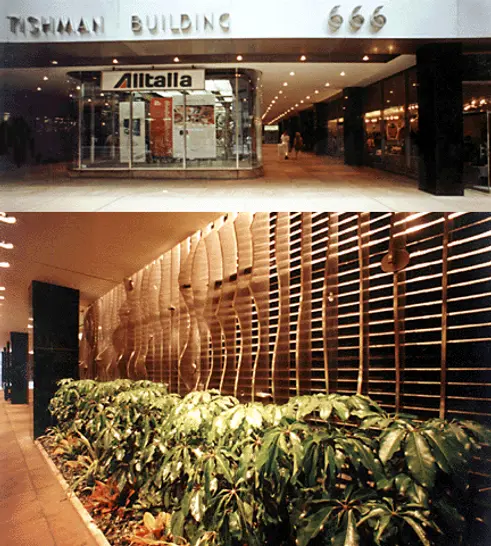 666 Fifth's former arcade and lobby; From Carter Horsley's CityReview
666 Fifth's former arcade and lobby; From Carter Horsley's CityReview
In this article:
In their great book, “New York 1960, Architecture and Urbanism Between the Second World War and the Bicentennial,” authors Robert A. M. Stern, Thomas Mellins and David Fishman wrote that “it was not until June 4, 1958, when Abe Feder’s extraordinary exterior lighting systems, using seventy-two reflector-type lamps, transformed it into a ‘Tower of Light,’ that the building became a landmark that received wide attention,” adding that “So bright was the night lighting that it was turned off between September 18 and November 1, 1959, to prevent disorienting migratory birds; the same restriction was also placed on the illuminated stationary beacon on the Empire State Building.”
The authors also noted that “Stouffer’s, the Ohio-based, middle-priced restaurant chain, opened a glamorous, upmarket cocktail and dining aerie called the Top of the Sixes, the first such facility since the Rainbow Room had opened atop the RCA Building in 1934.”
 Photo of the existing 666 Fifth Avenue; Image via Vornado Realty Trust
Photo of the existing 666 Fifth Avenue; Image via Vornado Realty Trust
666 Fifth Avenue was the second major metal-clad skyscraper after the Socony-Vacuum (later Socony-Mobil, later Mobil) Building designed by Harrison & Abramovitz opened in 1955 at 150 West 42nd Street as the largest office building undertaken in New York City since Rockefeller Center. It had 1.3-million square feet of office space compared to 666’s 1.25-million. It was more attractive than 666 Fifth and occupied a full block. It was the largest metal-clad office building in the world and the largest centrally air-conditioned office building ever built. In addition, its elevators were self-service and it had the largest office floors in the city.
While it and 666 did not spawn a host of imitators they were very important elements in the city’s history.
While it and 666 did not spawn a host of imitators they were very important elements in the city’s history.
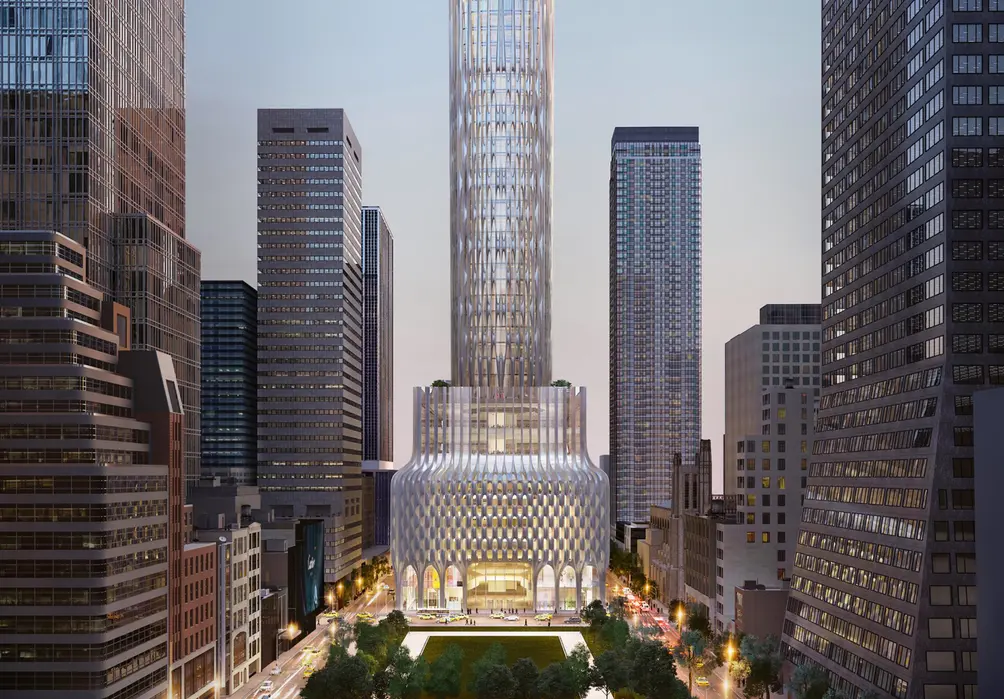 Lower floors of Zaha Hadid's design for 666 Fifth
Lower floors of Zaha Hadid's design for 666 Fifth
The new plan for 666 was designed by Zaha Hadid in 2015, a year before her death and it called for a building with 1.4-million square feet that would include an 8-story retail base, topped by a setback luxury hotel that would be under a setback and slimmer tower with luxury condominium apartments.
Based on the rendering that appeared in The Journal, it would appear that the retail base will have a three-story colonnade on the avenue beneath a very handsome, “woven” metallic base of alternating window fenestration that gives way in a “soft” and slightly curved setback in a short second base with a less complex façade with thin vertical piers that also extends from 52nd to 53rd streets.
Above the second base the narrow tower rises in four segments.
Above the second base the narrow tower rises in four segments.
The lower part of the tower has a curved façade with slightly angled piers in a “mesh” pattern that then elongates and then seems to open up a bit before ascending to the main residential section of the tower that is very slightly bowed and culminates in an attractive but short crown.
The Journal’s rendering indicates that the block across Fifth Avenue from the tower has been razed and replaced with a formally landscaped park, but that appears to have been artistic license to dramatize the vista of the tower.
The tower’s facades appear to be very handsome but its height is more than just a bit of a stretch. That height is about the same as another tower now in construction next to the Steinway Building on West 57th Street by JDS and designed by SHoP Architects, but that steps back from the north side of 57th Street but remains extremely splindly whereas this tower rises from a much larger base. Both towers raise a lot of questions about “SuperTalls” as they appear “vertiginously” in danger of falling over in strong gusts, which is hyperbole not wishful thinking. Clearly, they promise to be engineering marvels, and both are certainly aesthetically interesting if not wondrous.
They are, however, planning mistakes in their extreme excess and poor proportions.
The Journal’s rendering indicates that the block across Fifth Avenue from the tower has been razed and replaced with a formally landscaped park, but that appears to have been artistic license to dramatize the vista of the tower.
The tower’s facades appear to be very handsome but its height is more than just a bit of a stretch. That height is about the same as another tower now in construction next to the Steinway Building on West 57th Street by JDS and designed by SHoP Architects, but that steps back from the north side of 57th Street but remains extremely splindly whereas this tower rises from a much larger base. Both towers raise a lot of questions about “SuperTalls” as they appear “vertiginously” in danger of falling over in strong gusts, which is hyperbole not wishful thinking. Clearly, they promise to be engineering marvels, and both are certainly aesthetically interesting if not wondrous.
They are, however, planning mistakes in their extreme excess and poor proportions.
 Upper levels of Zaha Hadid's 666 Fifth Avenue
Upper levels of Zaha Hadid's 666 Fifth Avenue
Clearly, the fault here lies not with the developers but with the city’s planners and preservationists for not foreseeing the Supertall trend.
Not all Supertalls are bad, of course.
But the new generation of them is far from perfect. When Jean Nouvel designed his tower at West 53rd Street adjacent to the Museum of Modern Art, for example, Amanda Burden, then chairperson of the City Planning Commission, demanded that he redesign it and lower it by 200 feet on the absurd pretext it was “interfering” with the isolation and purity of the Empire State Building, 19 blocks to the south.
Yet the 666 Tower proposal and that of One Vanderbilt Avenue have not solicited similar demands from the City Planning Commission and are several hundred feet taller than the Nouvel tower now under construction.
In a city that thrives on zoning and preservation controversies, how could large swaths of the city have been overlooked?
Not all Supertalls are bad, of course.
But the new generation of them is far from perfect. When Jean Nouvel designed his tower at West 53rd Street adjacent to the Museum of Modern Art, for example, Amanda Burden, then chairperson of the City Planning Commission, demanded that he redesign it and lower it by 200 feet on the absurd pretext it was “interfering” with the isolation and purity of the Empire State Building, 19 blocks to the south.
Yet the 666 Tower proposal and that of One Vanderbilt Avenue have not solicited similar demands from the City Planning Commission and are several hundred feet taller than the Nouvel tower now under construction.
In a city that thrives on zoning and preservation controversies, how could large swaths of the city have been overlooked?
The simple reason is real estate economics.
No one, until very recently, imagined that luxury condominium space could command much greater market premiums than prime, first-class office space. That coupled with the fact that truly prime residential condominiums don’t like to share floor space with neighbors results in spindly and very thin towers that are springing up not only on “Billionaires’ Row” on 57th Street but in many other neighborhoods such as the Far East Side.
More than a generation ago, the city adopted provisions to prohibit the development of “sliver” buildings, primarily on the Upper East Side and a great controversy evolved over the shadows a proposed tower on Columbus Circle might cast on Central Park.
Yet no one has yet argued that shadows from the proposed tower at 666 Fifth Avenue might diminish the great glory of the Abby Aldrich Rockefeller Sculpture Garden at the Museum of Modern Art, half a block away.
More than a generation ago, the city adopted provisions to prohibit the development of “sliver” buildings, primarily on the Upper East Side and a great controversy evolved over the shadows a proposed tower on Columbus Circle might cast on Central Park.
Yet no one has yet argued that shadows from the proposed tower at 666 Fifth Avenue might diminish the great glory of the Abby Aldrich Rockefeller Sculpture Garden at the Museum of Modern Art, half a block away.
 Vornado Realty Trust (VNO)
Vornado Realty Trust (VNO)
And then there is the question of the propriety of demolishing a perfectly good and viable building of considerable note if its purity has been somewhat tarnished. In the case of 666 Fifth Avenue, its recent owners have permitted rather outrageous changes to its retail base.
At one point, the National Basketball Association was permitted to create a basketball net entrance to its new store in the building on the southern corner on the avenue. Then Uniqlo was permitted to enlarge its blockfront over the building’s traditional retail base on the northern corner on the avenue. Then Hollister recently was permitted to recess its entrance in the center of the building’s avenue frontage behind large pools of water.
Uniqlo and Hollister are not the worst tenants, of course, but they are victims of the market craze that puts street-front stores at the pinnacle of real estate values. Indeed, valuations of retail space in recent years has skyrocketed as some developers have gone wild creating multi-story storefronts that seriously scar and hurt the aesthetic integrity of the buildings in many instances, again, without a peep from most of the city’s preservationists and planners. The 666 Fifth Avenue project is being renamed 660 Fifth Avenue to wipe away memories of its former glory and it is being promoted as an “as-of-right” development that needs no public approvals. There have been reports that the museum is considering making the garden accessible to the public.
At one point, the National Basketball Association was permitted to create a basketball net entrance to its new store in the building on the southern corner on the avenue. Then Uniqlo was permitted to enlarge its blockfront over the building’s traditional retail base on the northern corner on the avenue. Then Hollister recently was permitted to recess its entrance in the center of the building’s avenue frontage behind large pools of water.
Uniqlo and Hollister are not the worst tenants, of course, but they are victims of the market craze that puts street-front stores at the pinnacle of real estate values. Indeed, valuations of retail space in recent years has skyrocketed as some developers have gone wild creating multi-story storefronts that seriously scar and hurt the aesthetic integrity of the buildings in many instances, again, without a peep from most of the city’s preservationists and planners. The 666 Fifth Avenue project is being renamed 660 Fifth Avenue to wipe away memories of its former glory and it is being promoted as an “as-of-right” development that needs no public approvals. There have been reports that the museum is considering making the garden accessible to the public.
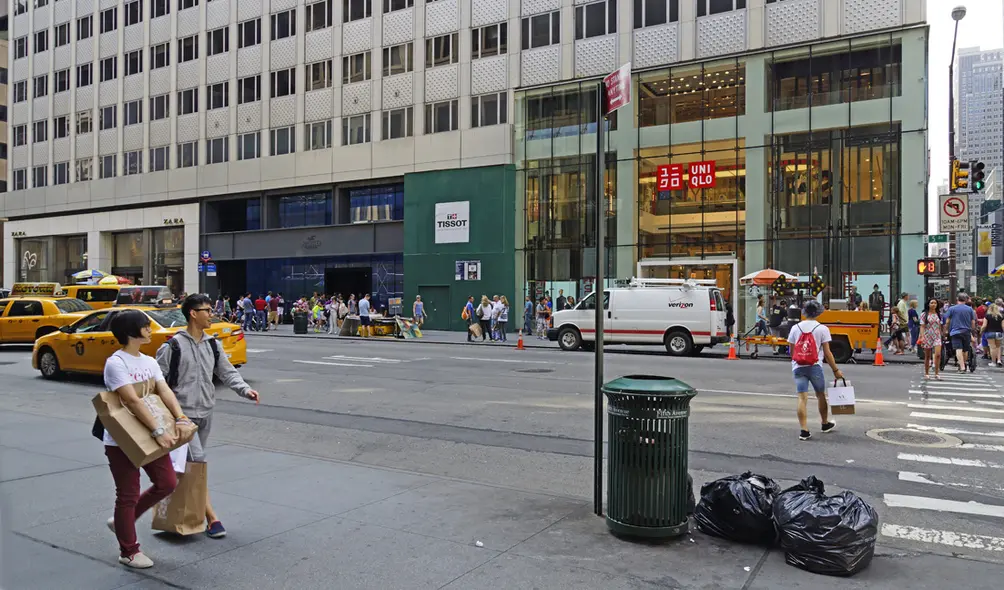 Base of 666 Fifth Avenue; Carter Horsley
Base of 666 Fifth Avenue; Carter Horsley
Perhaps it’s time for the Landmarks Preservation Commission to landmark the garden, one of the most cherished places in the city, and hold hearings on possible impact of 660 Fifth Avenue’s shadows on the MOMA garden and say “No.”
The developers who have paid for plans from Hadid’s architectural office can apply those plans to lots of sites in The Bronx, or the Far East Side, or Governor’s Island. The proposed tower appears to be pretty awesome and pretty and glittery, even if its proportions are a bit stretched.
According to a March 22, 2017 article by Peter Grant in The Wall Street Journal the 660 Fifth Avenue Project of Kushner Co. “could take until 2025 to complete” and Kushner Cos. “must cut a deal to buy out Vornado Realty Trust Inc., a real-estate investment trust that is its partner on office space and the owner of most of the property’s retail spaces.”
The article also said that “Charles Kushner also would have to buy out current tenants in the building, who have to move before demolition could start.” “Mr. Kushner’s son Jared is Mr. Trump’s son-in-law and a top White House adviser, which has ethics experts warning of conflicts of interest,” the article continued, noting that the young Mr. Kushner “has sold his personal stake in 666 Fifth Ave. and dozens of other properties to a trust controlled by other family members.”
According to a March 22, 2017 article by Peter Grant in The Wall Street Journal the 660 Fifth Avenue Project of Kushner Co. “could take until 2025 to complete” and Kushner Cos. “must cut a deal to buy out Vornado Realty Trust Inc., a real-estate investment trust that is its partner on office space and the owner of most of the property’s retail spaces.”
The article also said that “Charles Kushner also would have to buy out current tenants in the building, who have to move before demolition could start.” “Mr. Kushner’s son Jared is Mr. Trump’s son-in-law and a top White House adviser, which has ethics experts warning of conflicts of interest,” the article continued, noting that the young Mr. Kushner “has sold his personal stake in 666 Fifth Ave. and dozens of other properties to a trust controlled by other family members.”
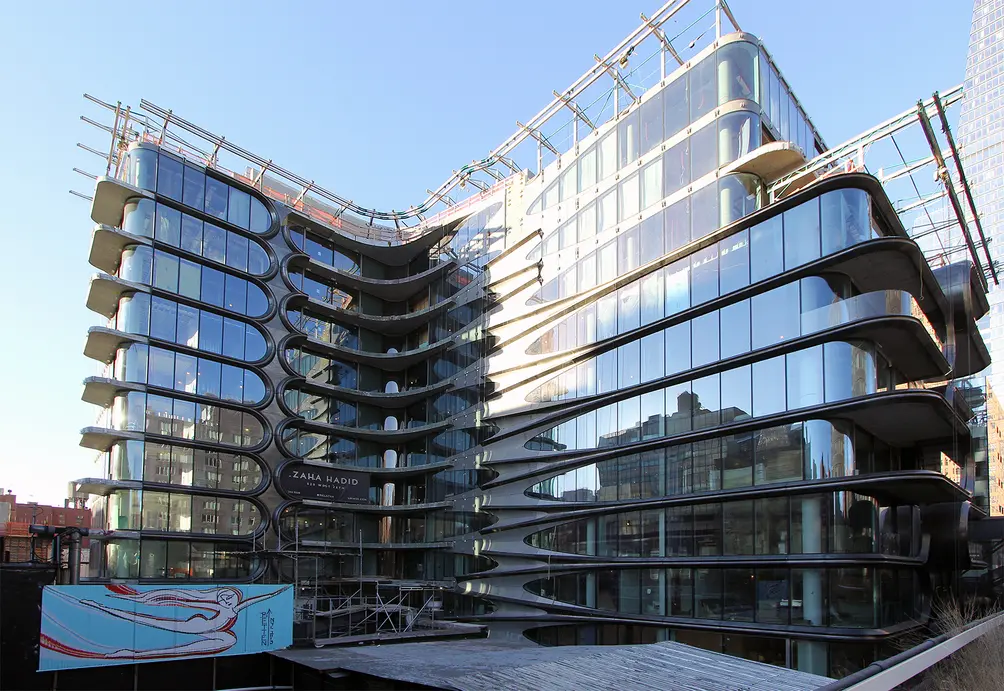 520 West 28th Street by Zaha Hadid Architects
520 West 28th Street by Zaha Hadid Architects
Ms. Hadid, who was born in Iraq, won the very prestigious Pritzker Prize for Architecture in 2004.
Early in her career worked by the Office for Metropolitan Architecture led by Rem Koolhaas who is tied with Frank O. Gehry as the world’s most important architect. She gained considerable notice for her very dashing drawings of a shard landscape in 1982 for the Peak Club in Hong Kong, one of her many unbuilt projects. She died a year ago and is well known for the 2010 Maxxi modern art museum in Rome that was described by Michael Kimmelman in his March 31, 2016 obituary of her in The New York Times as not “entirely practical, but it was a voluptuous and muscular building, multi-tiered, with ramps that flowed like streams and floors tilted like hills, many walls swerving and swooning.”
She was one of six architects including in the important “Deconstructivism in Architecture” show at the Museum of Modern Art in 1988.
Other important Hadid designs include the 2005 ship-like Phaeno Science Center in Wolfsburg, Germany, the 2005 BMW Administration Building with its leaning support columns, the 2010 Sheik Zayed Bridge whose dramatically curved design evokes undulating sand dunes in Abu Dbabi, United Arab Emirates, the “two pebble” 2010 Guangzhou Opera House in China,, the 2011 London Aquatics Centre, the 2011 “graph-chart” Riverside Museum in Glasgow, the 2013 corrugated stainless-steel Broad Art Museum in East Lansing, Michigan, the spaceship-like 2013 Dongdaemum Design Plaza in Seoul, and the Port Authority Building in Antwerp that looks like a crystalline whale about to breach perched atop a derelict fire station.
Early in her career worked by the Office for Metropolitan Architecture led by Rem Koolhaas who is tied with Frank O. Gehry as the world’s most important architect. She gained considerable notice for her very dashing drawings of a shard landscape in 1982 for the Peak Club in Hong Kong, one of her many unbuilt projects. She died a year ago and is well known for the 2010 Maxxi modern art museum in Rome that was described by Michael Kimmelman in his March 31, 2016 obituary of her in The New York Times as not “entirely practical, but it was a voluptuous and muscular building, multi-tiered, with ramps that flowed like streams and floors tilted like hills, many walls swerving and swooning.”
She was one of six architects including in the important “Deconstructivism in Architecture” show at the Museum of Modern Art in 1988.
Other important Hadid designs include the 2005 ship-like Phaeno Science Center in Wolfsburg, Germany, the 2005 BMW Administration Building with its leaning support columns, the 2010 Sheik Zayed Bridge whose dramatically curved design evokes undulating sand dunes in Abu Dbabi, United Arab Emirates, the “two pebble” 2010 Guangzhou Opera House in China,, the 2011 London Aquatics Centre, the 2011 “graph-chart” Riverside Museum in Glasgow, the 2013 corrugated stainless-steel Broad Art Museum in East Lansing, Michigan, the spaceship-like 2013 Dongdaemum Design Plaza in Seoul, and the Port Authority Building in Antwerp that looks like a crystalline whale about to breach perched atop a derelict fire station.
And Hadid already has a Manhattan project nearing completion on the High Line: a swooshing mid-rise residential condominium at 520 West 28th Street with Hadid’s signature voluptuous curves. It is one of several starchitect projects that have transformed the desolate wasteland of Far West Midtown into a major new residential district in Chelsea south of the gigantic Hudson Yards project that is a very long walk from midtown.

Architecture Critic
Carter Horsley
Since 1997, Carter B. Horsley has been the editorial director of CityRealty. He began his journalistic career at The New York Times in 1961 where he spent 26 years as a reporter specializing in real estate & architectural news. In 1987, he became the architecture critic and real estate editor of The New York Post.

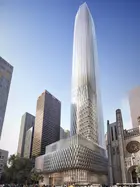
 6sqft delivers the latest on real estate, architecture, and design, straight from New York City.
6sqft delivers the latest on real estate, architecture, and design, straight from New York City.
